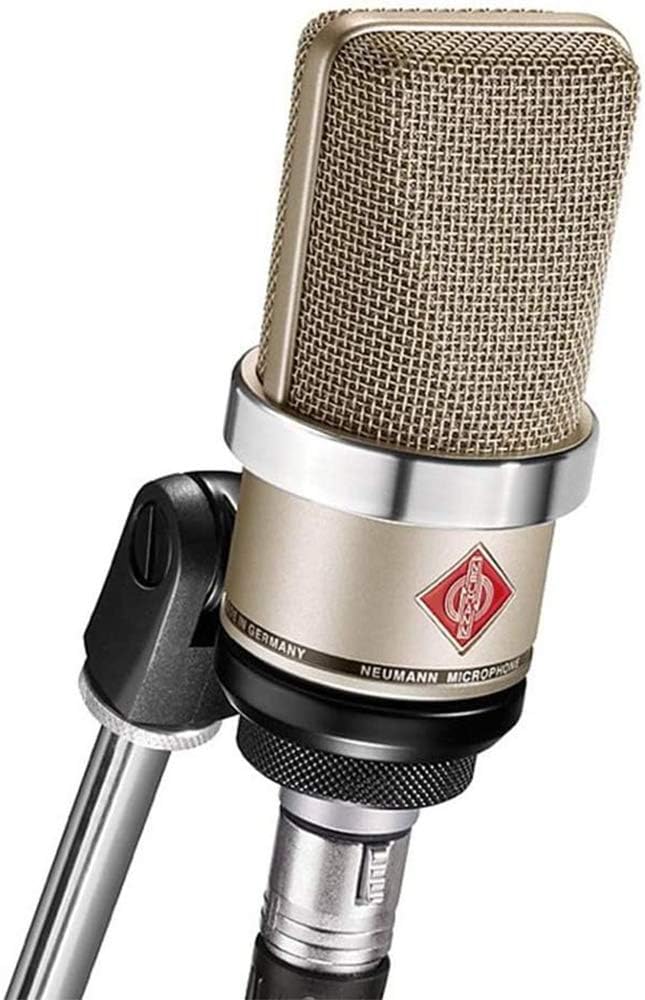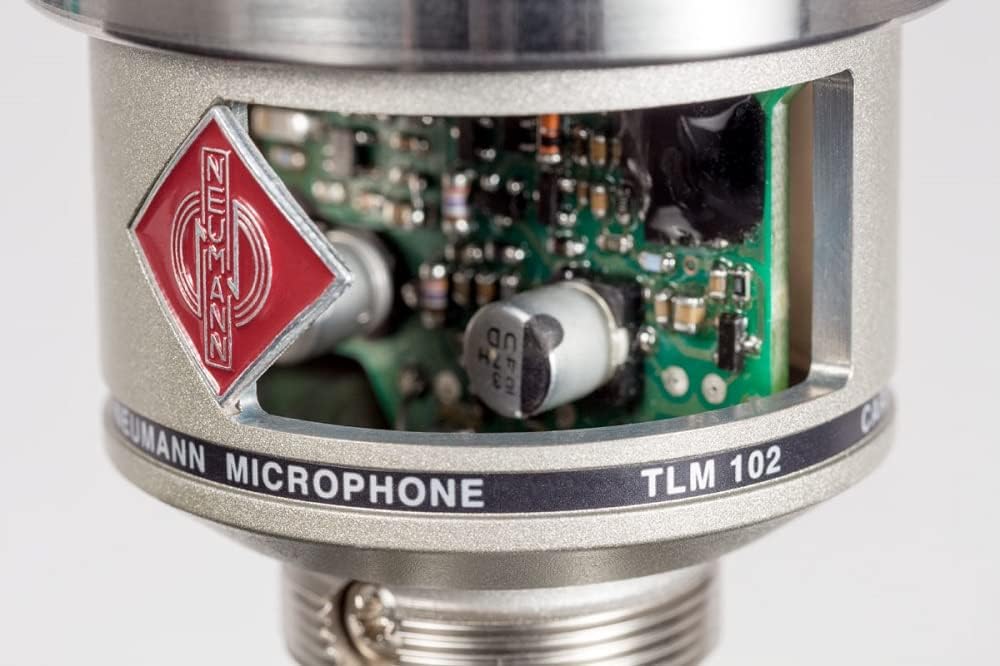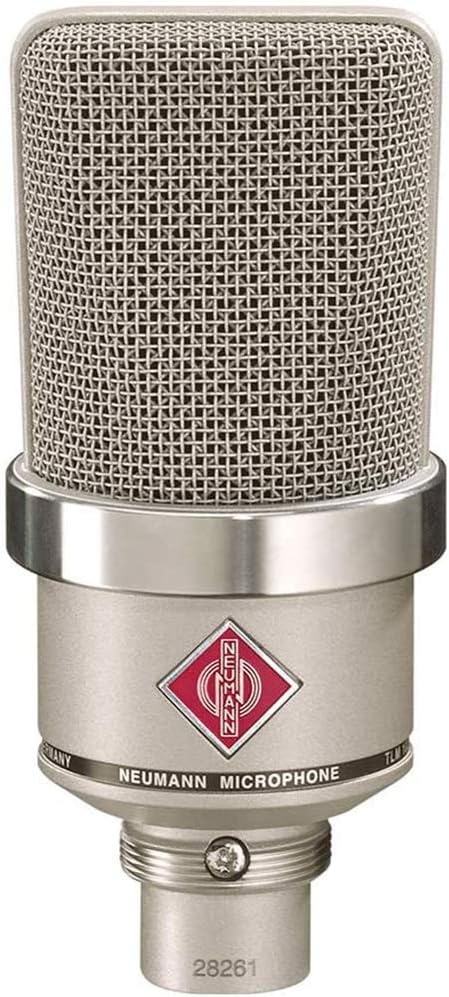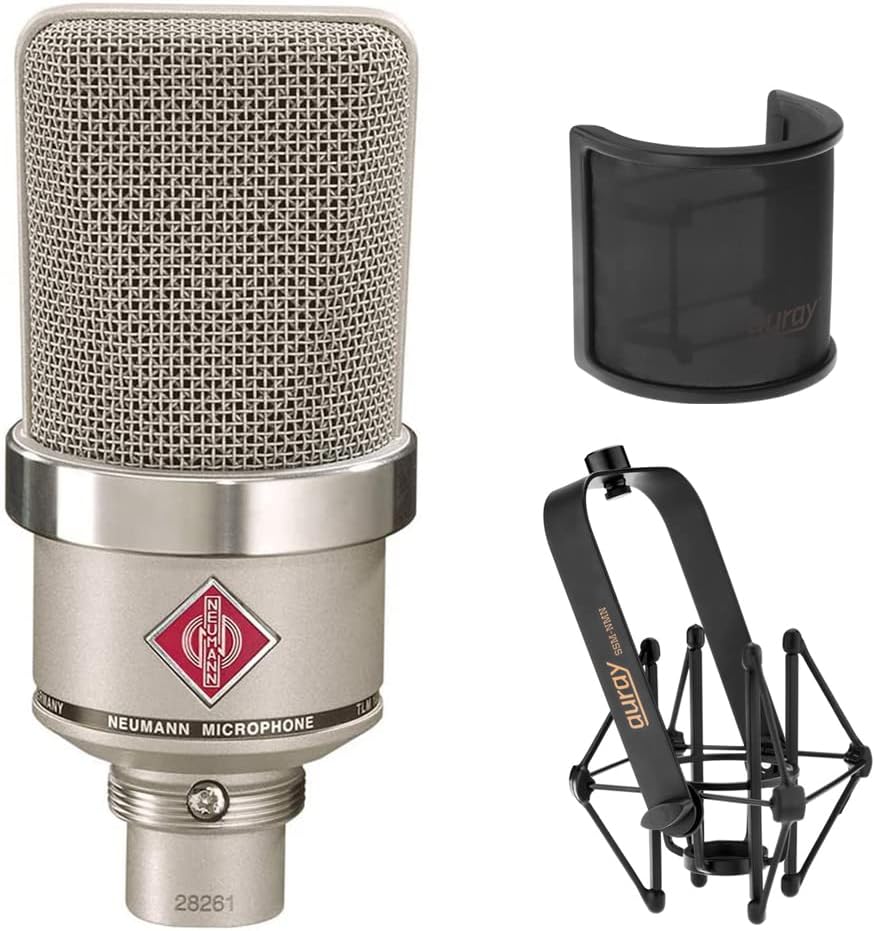Neumann TLM 102 Review
When it comes to microphones, Neumann is a name that carries weight. For decades, the German manufacturer has been synonymous with pristine audio quality, crafting tools that have captured some of the most iconic recordings in history. The Neumann TLM 102, introduced in 2009, represents a more accessible entry into this storied legacy. Marketed as a compact, large-diaphragm condenser microphone, the TLM 102 promises professional-grade performance at a price point that doesn’t require a studio-sized budget. But does it live up to the Neumann name? In this review, we’ll explore its design, sound quality, practical applications, and whether it’s worth your investment in 2025.
Neumann TLM 102 Review
Out of the box, the Neumann TLM 102 feels like a premium product. At just 7.5 inches long and weighing 210 grams (without its mount), it’s noticeably smaller and lighter than many of Neumann’s other offerings, like the U 87 or TLM 103. This compact form factor makes it a breeze to position in tight studio spaces or even on location, yet it retains that unmistakable Neumann aesthetic: sleek, minimalist, and purposeful.
The microphone is available in two finishes—matte black and nickel—both of which exude a understated elegance. Its cylindrical body is made from solid metal, giving it a robust feel that suggests it can withstand years of use. The grille, which protects the capsule, is sturdy and finely meshed, designed to minimize plosives and sibilance without the need for an external pop filter in many cases (though one is still recommended for close-up vocal work).
The TLM 102 ships with a simple SG 2 swivel mount, which is functional but basic. It holds the mic securely, though some users might prefer a shock mount (sold separately) for isolating it from vibrations in livelier recording environments. There’s no included carrying case or pouch in the standard package, which feels like a minor oversight for a mic in this price range—around $700 USD as of 2025—but it’s a small quibble given the quality of the microphone itself.
One standout feature of the TLM 102’s design is its transformerless circuitry (hence the “TLM” in its name, standing for “Transformerless Microphone”). This not only contributes to its compact size but also ensures a clean, uncolored signal path, which we’ll dive into more when discussing its sound.
The Heart of the Mic
At the core of the TLM 102 is a large-diaphragm, pressure-gradient transducer with a cardioid polar pattern. The capsule is derived from Neumann’s legendary K67 design, found in pricier models like the U 87, but optimized here for a smaller footprint and a slightly different sonic character. It’s worth noting that while the TLM 102 is often compared to its sibling, the TLM 103, it’s not simply a “budget version.” The 102 has its own personality, tailored for versatility rather than emulating a specific vintage sound.
The mic boasts an impressive frequency response of 20 Hz to 20 kHz, capturing the full spectrum of human hearing. Its self-noise is remarkably low at 11 dB-A, making it one of the quieter mics in its class—a crucial factor for recording delicate sources like acoustic instruments or soft vocals. The maximum sound pressure level (SPL) is 144 dB, meaning it can handle loud sources like drums or guitar amps without distortion, though it’s not quite as robust as some studio workhorses designed specifically for high-SPL applications.
The TLM 102 requires 48V phantom power and connects via a standard XLR cable (not included). It lacks onboard switches for pad or low-cut filters, which keeps the design clean but might disappoint users who prefer those controls at their fingertips. For most, however, these adjustments can be easily handled at the preamp or in post-production.
Sound Quality
So, how does the TLM 102 sound? In a word: exceptional. Neumann describes it as having a “slight presence boost” above 6 kHz, and that’s immediately apparent when you listen. This subtle lift adds air and detail to vocals and instruments, giving recordings a polished, professional sheen without sounding overly hyped or artificial.
When tested on vocals, the TLM 102 shines. It captures the nuances of a singer’s performance—every breath, inflection, and texture—with a warmth that’s inviting yet never muddy. Compared to brighter mics, like a Rode NT1, the TLM 102 feels more balanced, avoiding harshness in the upper mids while still delivering clarity. On a male baritone voice, it emphasized the richness of the lower register without sacrificing intelligibility. For a higher-pitched female vocal, the presence boost brought out the sparkle without tipping into sibilance.
Acoustic guitar is another area where the TLM 102 excels. Positioned about 6-12 inches from the 12th fret, it captures the instrument’s body and string detail beautifully. The low end is tight and controlled, while the highs shimmer without being piercing. Pair it with a second mic for stereo recording, and you’ve got a setup that rivals far more expensive rigs.
On louder sources, like an electric guitar cabinet or drum overheads, the TLM 102 holds its own, though it’s not its primary strength. The 144 dB SPL handling is respectable, but it can start to feel slightly strained with extremely loud sources. For these applications, a dynamic mic or a condenser with a pad switch might be a better fit. Still, its ability to double as a utility player in the studio is a testament to its versatility.
One potential critique is that the TLM 102 doesn’t have the same “larger-than-life” character as some of Neumann’s vintage-inspired models. If you’re chasing the bold, authoritative sound of a U 47 or U 67, this isn’t that mic. Instead, it offers a modern, transparent sound with just enough personality to stand out—a quality that makes it ideal for today’s diverse recording needs.
Where It Fits
The TLM 102 is marketed as a “studio microphone for all applications,” and while that’s a lofty claim, it’s not far off the mark. Its cardioid pattern makes it best suited for single-source recording, rejecting off-axis noise effectively in untreated rooms. This, combined with its low self-noise and high SPL capability, positions it as a Swiss Army knife for home studios, project studios, and even professional setups on a budget.
For podcasters and voiceover artists, the TLM 102 is a dream. Its vocal clarity and built-in pop protection (though a filter is still wise) make it a plug-and-play option that elevates spoken word recordings. Streamers and content creators looking to upgrade from USB mics will find it a worthwhile investment, especially paired with a decent audio interface.
Musicians will appreciate its flexibility. It’s a fantastic choice for singer-songwriters tracking vocals and guitar simultaneously (with a second mic or in separate takes). In a band setting, it can handle everything from piano to percussion, though it’s less ideal as a primary drum mic due to its sensitivity and lack of a pad.
In professional studios, the TLM 102 often serves as a complementary mic rather than the star of the show. It’s not uncommon to see it used alongside a U 87 or TLM 103 for stereo pairs or spot-miking duties. Its compact size also makes it a favorite for location recording, where portability and quality must coexist.
Comparisons: TLM 102 vs. the Competition
At around $700, the TLM 102 sits in a competitive mid-tier market. How does it stack up?
- Neumann TLM 103 ($1,200): The TLM 103, its bigger sibling, offers a broader, more authoritative sound with a slightly flatter frequency response. The 102, however, is more compact, less expensive, and has a touch more presence boost, making it better for sources needing extra “pop.”
- Rode NT1 ($269): The NT1 is a budget-friendly favorite with ultra-low self-noise (4.5 dB-A). While it’s cleaner and brighter, it lacks the TLM 102’s warmth and build quality. The Neumann feels like a long-term investment; the Rode is a steal for beginners.
- AKG C214 ($479): The C214 offers a pad and low-cut switch, plus a more aggressive high-end. The TLM 102 counters with superior transparency and a smoother response, though it’s pricier.
- Audio-Technica AT4040 ($299): The AT4040 is versatile and affordable, but its sound is less refined than the TLM 102’s, with a slightly scooped midrange.
The TLM 102 justifies its price with the Neumann badge, exceptional build, and a sound that punches above its weight. For those who can afford it, it’s a step up from budget condensers without breaking into four-figure territory.
Pros and Cons
Pros:
- Outstanding clarity and warmth
- Low self-noise (11 dB-A)
- Compact, durable design
- Versatile for vocals, instruments, and speech
- High SPL handling (144 dB)
Cons:
- No pad or low-cut switch
- Basic included mount
- Not as “characterful” as vintage Neumanns
- Price may still be steep for hobbyists
Conclusion: Is the TLM 102 Worth It?
The Neumann TLM 102 is a triumph of engineering—a microphone that distills the brand’s heritage into a modern, accessible package. It’s not the cheapest option, nor is it the most feature-packed, but it delivers where it matters most: sound quality. For home studio owners looking to step up their game, or professionals needing a reliable all-rounder, it’s a worthy contender. Its balance of transparency and subtle character makes it a tool that can grow with you, from first demos to polished productions.
In 2025, with recording technology more democratized than ever, the TLM 102 stands out as a bridge between entry-level gear and high-end studio staples. If your budget allows, and you value quality over bells and whistles, the Neumann TLM 102 is an investment that will pay dividends in every track you record. It’s not just a microphone—it’s a statement of intent.




